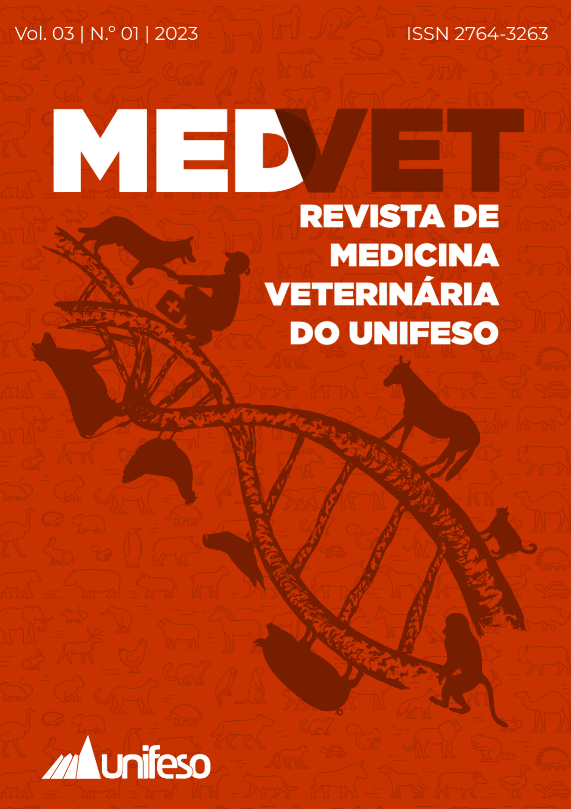DOENÇA DO BICO E DAS PENAS DOS PSITACÍDEOS EM RING NECK (Psittacula krameri) – RELATO DE CASO
Palavras-chave:
Palavras-chave, Timomodulina. β-(1, 3/1, 6)-D-Glucano. Circovírus.Resumo
A Doença do Bico e das Penas dos Psitacídeos é uma doença infecciosa crônica, causada por
um Circovirus, que geralmente afeta Psittaciformes. Esta é altamente contagiosa, ocorrendo através da
ingestão ou inalação de partículas que contenham o vírus, que são liberadas por células da descamação
das penas das aves, quando voam, se remexem ou se limpam. O vírus também pode ser eliminado nas
fezes e por secreções do papo, contaminando o ambiente. O diagnóstico é feito através da histopatologia
ou PCR. Não existe um tratamento específico para a doença, apenas paliativo, proporcionando uma
melhor qualidade de vida para o animal. Este trabalho tem como objetivo relatar um caso de Doença
do Bico e das Penas dos Psitacídeos em Ring Neck (Psittacula krameri), a fim de demonstrar as formas
de diagnóstico, tratamento e profilaxia da doença. Um Ring Neck, fêmea, 8 meses de idade, teve como
sintomatologia, alopecia e pontos de sangue em folículos das penas, destruição do cálamo das rémiges,
nascimento de penas distróficas e alteração da pigmentação de penas de revestimento. Suspeitando-se
da Doença do Bico e das Penas dos Psitacídeos, foi realizado o diagnóstico por PCR das penas e fezes,
sendo o resultado positivo para a doença. Como tratamento foi utilizado Timomodulina 2ml/dia por via
oral, durante 90 dias, mais suplementação com β-(1,3/1,6) -D-Glucano, 1g/Kg de ração. Após um mês
de tratamento, a ave apresentou melhora no quadro e as penas voltaram a crescer. Visto que a doença não
tem cura e o tratamento é paliativo, a suplementação se torna ininterrupta.
Referências
Heath L, Martin DP, Warburton L, Perrin M,
Horsfield W, Kingsley C, et al. Evidence of
unique genotypes of beak and feather disease
virus in Southern Africa. Journal of Virology.
; 78(17):9277-9284.
Nath BK, Das S, Roby JA, Sarker S, Luque
D, Raidal SR, et al. Structural perspectives
of beak and feather disease virus and porcine
circovirus proteins. Viral Immunology. 2020;
(1) :49-59.
RITCHIE BW. Avian viruses: function and
control. Florida: Wingers Publishing Inc,
223-252 p.
Ritchie PA, Anderson IL, Lambert DM. Evidence
for specificity of psittacine beak and
feather disease viruses among avian hosts. Virology.
; 306(1):109-115.
Há HJ, Anderson IL, Alley MR, Springett BP,
Gartrell BD. The prevalence of beak and feather
disease virus infection in wild populations
of parrots and cockatoos in New Zealand. New
Zealand Veterinary Journal. 2007; 55(5):235-
Pass DA, Perry RA. The pathology of psittacine
beak and feather disease. Australian Veterinary
Journal. 1984; 61(3):69-74.
Kondiah K. Establishment of serological and
molecular techiques to investigate diversity of
psittacine beak and feather disease virus in different
psittacine birds in South Africa. 119f.
Dissertation. [Master Scientist] - Faculty of
Natural and Agricultural Sciences. University
of the Free State. Bloemfontein, AS; 2004.
Raidal, S. R.; Bonne, N. J.; Stewart, M. Development
of recombinant proteins as a candidate
vaccine for Psittacine Beak and Feather
Disease. In: Final Report for the Australian
Government Department of the Environment
and Heritage, 2004; Perth, AU. Murdoch University,
p. 1-91.
Ritchie BW, Harrison GJ, Harrison LR. Avian
medicine: principles and application. 1ªed.
Lake Worth: Wingers Publishing Inc, 1994.
-903 p.
Miesle MAJ, Ed M. Psittacine Beak and Feather
Disease: an overview. 21 p. 2018. [Acesso
abr. 2022]. Disponível em: https://www.
academia.edu/40376748/Psittacine_Beak_
And_Feather_Disease_An_Overview.
Raidal SR, Peters A. Psittacine beak and feather
disease: ecology and implications for conservation.
Emu-Austral Ornithology. 2018;
(1):80-93.
Paré JA, Robert N. Circovírus. In: Thomas NJ,
Hunter DB, Atkinson CT. Infectious diseases
of wild birds. Ames: Blackwell Publishing
Ltd, 2007. Cap. 9, p. 194-205.
Wylie SL. Studies on psittacine beak and feather
disease. 160f. Thesis. [Doctor of Philosophy]
- School of Veterinary Studies. Murdoch
University, Perth, AU; 1991.
Rahaus M, Desloges N, Probst S, Loebbert B,
Lantermann W, Wolff MH. Detection of beak
and feather disease virus DNA in embryonated
eggs of psittacine birds. Veterinarni Medicina.
; 53(1):53-58.
Thongchan D, Huang YL, Khatri-Chhetri R,
Tsai SS, Wu HY. Prevalence and pathology
of avian polyomavirus (APV) and psittacine
beak and feather disease virus (PBFDV) infections
in Taiwan: a retrospective study from
to 2014. RMUTI Journal Science and
Technology. 2015; 9(2):1-13.
Phalen DN. Implications of viruses in clinical
disorders. In: Harrison GJ, Lightfoot TL. Clinical
avian medicine. 2ªed. Florida: Spix publishing,
Cap. 32, p. 721-746.
Tomasek O, Tukac V. Psittacine circovirus infection
in parakeets of the genus Eunymphicus
and treatment with β-(1, 3/1, 6)-D-Glucan.
Avian diseases. 2007; 51(4):989-991.
Gerlach H. Circoviridae: Psittacine Beak and
Feather Disease Virus. In: Ritchie BW, Harrisson
GJ, Zantop D, Harrison LR. Avian medicine:
principles and application. 1ªed. Florida:
Wingers Publishing Inc, 1994. Cap. 32, p.
-903.
Bert E, Tomassone L, Peccati C, Navarrete
MG, Sola SC. Detection of beak and feather
disease virus (BFDV) and avian polyomavirus
(APV) DNA in psittacine birds in Italy. Journal
of Veterinary Medicine. Series B. 2005;
(2):64-68.


